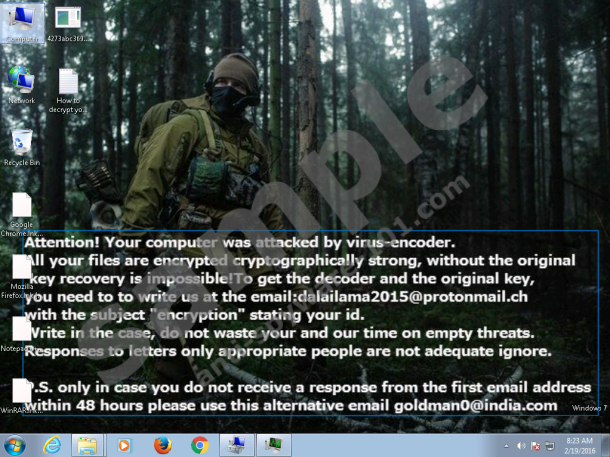What is Crysis Ransomware?
Crysis Ransomware is an infection that uses AES encryption to encrypt your personal files, as well as the files of programs that you have installed on your PC. Although this infection does not touch Windows files and Internet Explorer, other files are in danger of getting corrupted. Unfortunately, the encryption process is silent, and most users do not realize that files are being corrupted. Once encrypted, the files are very easy to identify. First of all, you will not be able to open them. Second, they will be renamed with an added email address and a second extension (e.g., file.exe.{dalailama2015@protonmail.ch}.CrySiS). The email address attached to the name coincides with the email provided via a wallpaper message or a .txt file, "How to decrypt your data.txt"; however, our Anti-Spyware-101.com researchers warn that this email could change. What do not change are the strategies of this infection and the reasons to remove Crysis Ransomware.
How does Crysis Ransomware work?
Are you familiar with PadCrypt Ransomware, JobCrypter Ransomware, HydraCrypt Ransomware, or any other infections that are capable of encrypting files? Crysis Ransomware is very similar to these threats, but it is more vicious because it is capable of encrypting the files of installed software. For example, this threat could encrypt the files of antivirus tools. Of course, if existing security software was encrypted successfully, it is most likely that it was unreliable or outdated to begin with; otherwise, it would have protected your operating system against this ransomware. Unfortunately, this malicious ransomware also encrypts the files of your web browsers, except for Internet Explorer, which might make it more difficult for you to search for useful information. This is meant to ensure that you are focused on the demands presented to you. As mentioned previously, these demands are introduced to you via a .txt file – which you might find on the Desktop and in any location containing encrypted files – as well as the wallpaper message. Obviously, you can delete the photo file representing the ransomware wallpaper, and you can eliminate the .txt files.
The devious Crysis Ransomware requires you to contact one of the provided emails. If you do, there is no doubt that you would receive additional instructions that are likely to involve making a payment. This ransom might be the only way to decrypt your personal files – if you have not backed them up – however, you must keep in mind that cyber criminals are not to be trusted. Are you sure that your files would be decrypted if you followed the requirements presented by cyber criminals? Well, we are not 100% sure about this. The problem is that once your files are encrypted, you cannot decrypt them easily because the decryption key – which is introduced as the “original key” by this ransomware – is stored in a remote location. It is up to the creator of this ransomware whether or not this decryption key will be provided to you. Hopefully, your files are backed up, and you can easily reinstall the programs whose files got encrypted, in which case, you should waste no more time and delete Crysis Ransomware.
How to remove Crysis Ransomware
Even if you pay the ransom, you need to eliminate Crysis Ransomware from your Windows operating system because its files could perform malicious activity again. Whether or not you are experienced, we suggest implementing a reliable malware remover to get rid of this infection. A reliable tool will not only eliminate this ransomware but will also help you get rid of any other remaining infections. Are you sure that other infections are not active on your PC? Although ransomware infections usually spread via corrupted spam email attachments, our researchers warn that they could be bundled along with other malicious threats as well. Obviously, if you choose the manual removal option, you will need to check for leftovers yourself. When it comes to manual removal, it is difficult to find the executable file of this threat because its location, as well as its name, is very unpredictable. Use the guide below to erase this ransomware.
Removal Guide
- Launch the Explorer by tapping Win+E keys.
- Enter these directories into the address bar at the top one by one. Check these directories, as well as the subfolders within them, for suspicious executables that might belong to the ransomware.
- %LocalAppData%
- %UserProfile%\Local Settings\Application Data
- %WINDIR%\System32
- %TEMP%
- %UserProfile%\downloads
- Right-click the malicious executable (take note of the name first) and select Delete.
- Launch the RUN dialog box by tapping Win+R keys and enter regedit.exe.
- Click OK to launch the Registry Editor.
- Go to HKEY_LOCAL_MACHINE\SOFTWARE\Microsoft\Windows\CurrentVersion\Run.
- Right-click the value whose name coincides with the malicious executable and select Delete.
- Go to HKEY_LOCAL_MACHINE\SOFTWARE\Wow6432Node\Microsoft\Windows\CurrentVersion\Run.
- Repeat step 7.
- Tap Win+E again, move to the menu on the left, and open the Documents folder.
- Right-click and Delete the photo file of the malicious ransomware.
tested removal of Crysis Ransomware*






0 Comments.